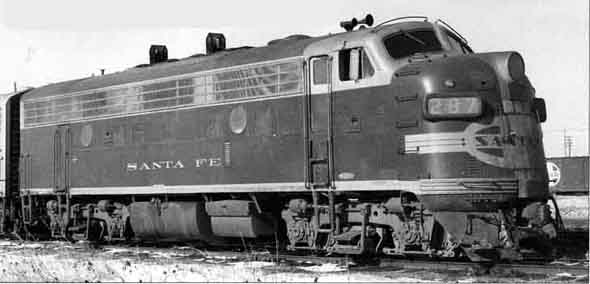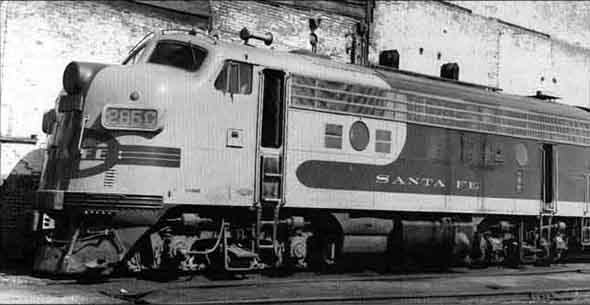Santa Fe Freight F9's |
|
Road numbers 281LABC through 289LABC The Santa Fe's last new F-unit purchase came in 1956 when F9's 281LABC through 289LABC were delivered. They came from the factory in blue/yellow with the passenger nose emblem. These units had single headlights, vertical slit grilles, vertical slit filter openings between the portholes, ari piping on the roof, 48" D/B fans, and wide fuel tanks with abbreviated skirting as carried over from late F7 production. The F9's were initially assigned in Texas and seldom strayed from there until the late 1960's when they were placed in service system wide. Many of the F9's went into the CF-7 rebuild program and three of them gave up their prime movers for rebuild of three Alco RSD-15's into CRSD-20's, 01 and 02. A number of the F9's were repainted into the yellow warbonnet freight scheme during the 1970's with at least three variations in the nose emblem known to exist. Some units had a blue nose stripe ukp and over the headlight to the base of the windshield (286L, 285C) some had an abbrevaiated stripe that ended just below the headlight (284C, 289C), others had just the nose emblem without a nose stripe (287C, 288L) No HO model has been produced that could be used for a Santa Fe F9 without modification, but Stewart's F9A could be reworked to Santa Fe appearance with some effort, mostly in the area of the fuel tank and skirts - incorrect for Santa Fe F9's. Bachmann's F9 may have possibilities as well for re-detailing and painting, although its very poor mechanism would have to be replaced. It is know to have been produced with either single or dual headlights in the body casting. F9B's differed little in external appearance from F7B's. Any F7B could be reworked to an F9B with addition of a Highliner 48" D/b fan, Detail Associates vertical slit grilles, air piping on the roof and fuel tank modifications. As with the FT's, the F3, F7, and F9 freight units underwent modifications over the years that gave them distinct Santa Fe character. Grab irons were added above the cab windows and up the right side of the nose on A-units and many, but not all, had wrecking lugs on the nose and rear carbody and nose MU receptacles installed. Those A-units that never had nose MU installed reportedly caused a lot of headaches at engine terminals in their later years as they had to be placed at one end or the other of whatever locomotive consist they were to operate with. Most F7 units had the fuel tank skirts completely removed while F9's were delivered with precious little skirting. All locomotives received radio antennas of various types, some F7's getting the very early Sinclair "wagon wheel" antennas very soon after they were built. A few F7's had flat plate antennas, but most had either the "wagon wheel" type at the left rear of the roof or a simple "can" type on the roof mounted directly on the carbody. |
 F9A 287L does not have wrecking lugs installed on the nose, but she does have MU, extra grab irons and spark arrestors. The fuel tank skirting has been removed. The growth of grab irons was caused by federal safety rules in the late 50's or early 60's. By July 1970 there was little window washing cone at Emporia. |
 F9A 285 sits next to the Amarillo roundhouse sunning her yellow warbonnet livery. The blue stripe up and over the headlight is one of three known variations in the nose treatment of this class. many of the 281 class A-units were rebuilt to CF-7's (still classed as such even though they were F9's to bigin with). Photo was made in July 1974 and she became CF-7 2436 in October 1977. |







